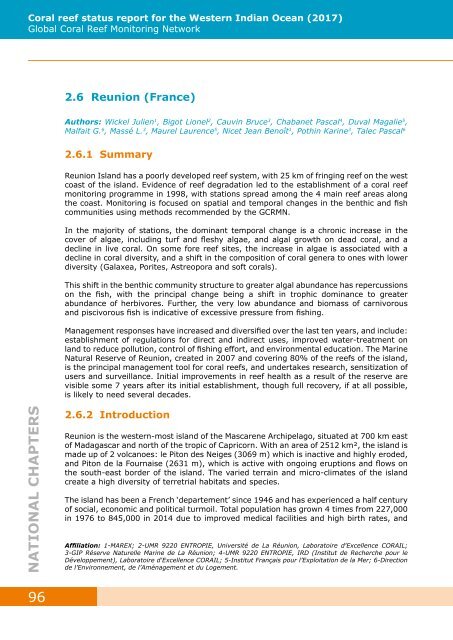GCRMN_COI_2017-Western Indian Ocean Reef Status
GCRMN Western Indian Ocean Coral Reef Status report for 2017. Produced by the Indian Ocean Commission and CORDIO East Africa
GCRMN Western Indian Ocean Coral Reef Status report for 2017. Produced by the Indian Ocean Commission and CORDIO East Africa
You also want an ePaper? Increase the reach of your titles
YUMPU automatically turns print PDFs into web optimized ePapers that Google loves.
Coral reef status report for the <strong>Western</strong> <strong>Indian</strong> <strong>Ocean</strong> (<strong>2017</strong>)<br />
Global Coral <strong>Reef</strong> Monitoring Network<br />
2.6 Reunion (France)<br />
Authors: Wickel Julien 1 , Bigot Lionel 2 , Cauvin Bruce 3 , Chabanet Pascal 4 , Duval Magalie 5 ,<br />
Malfait G. 6 , Massé L. 3 , Maurel Laurence 5 , Nicet Jean Benoît 1 , Pothin Karine 3 , Talec Pascal 6<br />
2.6.1 Summary<br />
Reunion Island has a poorly developed reef system, with 25 km of fringing reef on the west<br />
coast of the island. Evidence of reef degradation led to the establishment of a coral reef<br />
monitoring programme in 1998, with stations spread among the 4 main reef areas along<br />
the coast. Monitoring is focused on spatial and temporal changes in the benthic and fish<br />
communities using methods recommended by the <strong>GCRMN</strong>.<br />
In the majority of stations, the dominant temporal change is a chronic increase in the<br />
cover of algae, including turf and fleshy algae, and algal growth on dead coral, and a<br />
decline in live coral. On some fore reef sites, the increase in algae is associated with a<br />
decline in coral diversity, and a shift in the composition of coral genera to ones with lower<br />
diversity (Galaxea, Porites, Astreopora and soft corals).<br />
This shift in the benthic community structure to greater algal abundance has repercussions<br />
on the fish, with the principal change being a shift in trophic dominance to greater<br />
abundance of herbivores. Further, the very low abundance and biomass of carnivorous<br />
and piscivorous fish is indicative of excessive pressure from fishing.<br />
Management responses have increased and diversified over the last ten years, and include:<br />
establishment of regulations for direct and indirect uses, improved water-treatment on<br />
land to reduce pollution, control of fishing effort, and environmental education. The Marine<br />
Natural Reserve of Reunion, created in 2007 and covering 80% of the reefs of the island,<br />
is the principal management tool for coral reefs, and undertakes research, sensitization of<br />
users and surveillance. Initial improvements in reef health as a result of the reserve are<br />
visible some 7 years after its initial establishment, though full recovery, if at all possible,<br />
is likely to need several decades.<br />
NATIONAL CHAPTERS<br />
2.6.2 Introduction<br />
Reunion is the western-most island of the Mascarene Archipelago, situated at 700 km east<br />
of Madagascar and north of the tropic of Capricorn. With an area of 2512 km², the island is<br />
made up of 2 volcanoes: le Piton des Neiges (3069 m) which is inactive and highly eroded,<br />
and Piton de la Fournaise (2631 m), which is active with ongoing eruptions and flows on<br />
the south-east border of the island. The varied terrain and micro-climates of the island<br />
create a high diversity of terretrial habitats and species.<br />
The island has been a French ‘departement’ since 1946 and has experienced a half century<br />
of social, economic and political turmoil. Total population has grown 4 times from 227,000<br />
in 1976 to 845,000 in 2014 due to improved medical facilities and high birth rates, and<br />
Affiliation: 1- MAREX; 2- UMR 9220 ENTROPIE, Université de La Réunion, Laboratoire d'Excellence CORAIL;<br />
3- GIP Réserve Naturelle Marine de La Réunion; 4- UMR 9220 ENTROPIE, IRD (Institut de Recherche pour le<br />
Développement), Laboratoire d'Excellence CORAIL; 5- Institut Français pour l’Exploitation de la Mer; 6- Direction<br />
de l’Environnement, de l’Aménagement et du Logement.<br />
96


















